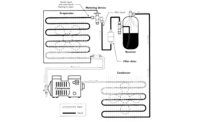Frost on an evaporator coil will prevent the correct amount of airflow across the coil. Anytime the evaporator coil experiences reduced airflow across its face, there will be a reduced heat load on the coil. Low airflow across the evaporator coil can cause much of the refrigerant in the coil to remain a liquid and not vaporize as fast. Some liquid refrigerant may travel past the evaporator coil, through the suction line, and eventually get to the compressor, which can result in compressor damage from flooding and/or slugging.
Figure 1 shows an air-source heat pump with a severely frosted outdoor (evaporator) coil. The frosted coil is preventing the majority of the air from flowing through the outdoor coil, which in turn, will prevent the refrigerant in the coil from experiencing the proper heat loading. A dirty evaporator coil can also cause a reduced airflow across the evaporator, which will then cause reduced heat loading on the refrigeration system.
Listed below are several system problems that can reduce the airflow and heat loading across the evaporator coil and cause frost to accumulate:
- Evaporator fan burned out;
- Dirty evaporator coil;
- Defrost component malfunctions;
- Not enough actual heat load on the evaporator coil;
- Defrost intervals set too far apart;
- Inoperative defrost heater; and/or
- High humidity situation from door openings.
FROST
Frost is probably the most common cause of a reduced heat load and reduced airflow across evaporator coils, which can cause inefficiency within the refrigeration system. When the evaporator’s coil temperature drops below the dewpoint temperature, dew will begin to collect on the evaporator’s cool surface (the dewpoint temperature is the temperature at which dew starts to form). If the temperature of the evaporator coil continues to drop below the freezing point of water, the moisture on the evaporator’s coil will begin to freeze into a thin layer of ice.
The first thin layer of ice on the evaporator coil will be very hard and will actually enhance the evaporator’s efficiency. Not only is this first layer of solid ice around the evaporator coil a good conductor of heat, it will also increase the surface area of the evaporator tubes. Thus, heat transfer into the evaporator’s coil will be increased. When the evaporator tubes have an increased surface area, the area for airflow around the tubes will be reduced. This will cause a slight increase in the air’s velocity through the coil, which will also increase heat transfer to the evaporator.
Depending on humidity, evaporator temperature, and airflow, the subsequent layers of frost that accumulate on the evaporator may be more crystalline or snow-like. These layers of frost will hold more entrained air and be very porous, and they will insulate the evaporator and severely reduce its heat-absorbing ability. As this porous type of frost accumulates, the evaporator will see less heat from the refrigerated space, which will cause the evaporator (suction) pressure — thus evaporator temperature — to drop, and the evaporator coil will become colder.
The drop in suction pressure will cause higher compression ratios, which will cause lower compressor volumetric efficiencies, less dense refrigerant return gases entering the compressor, reduced mass flow rates of refrigerant, and loss of system capacity. Severe cases of evaporator frosting can cause liquid refrigerant to return to the compressor. A result of this insulating effect is a lower evaporator pressure, causing the temperature of the evaporator coil to be reduced to maintain the same desired refrigerated space temperature. In this case, the temperature difference between the evaporator coil and the refrigerated space will be greater.
COMPRESSOR PROBLEMS
Service technicians often change out a compressor because of broken internal parts without finding the actual cause of the problem. However, the broken parts are not usually the cause of the problem; they could be the result of a faulty time clock or an open defrost heater not letting the system defrost properly. This would frost or ice the evaporator coil, causing flooding or slugging of the compressor, which could cause the broken internal parts in the compressor.
| Table 1: System check for an R-134a refrigeration system | |
| Compressor discharge temp | 88°F |
| Condenser outlet temp | 82°F |
| Evaporator outlet temp | minus 9°F |
| Compressor in temp | minus 8°F |
| Ambient temp | 75°F |
| Refrigerated box temp | 25°F |
| Compressor amperage | High |
| Evaporating pressure | 2.2 psig (minus 9°F) |
| Condensing pressure | 104 psig (90°F) |
| Condenser split | 15° |
| Condenser subcooling | 8° |
| Evaporator superheat | zero |
| Compressor superheat | 1° |
If the technician does not perform a system checklist and run the system through its modes after changing the compressor, the new compressor is sure to fail for the same reasons. Compressor manufacturers often ask technicians to examine malfunctioning compressors to help determine the cause of failure. Opening a semi-hermetic compressor and examining its internal parts does not void the warranty as long as all of the parts are returned with the old compressor.
Technicians should make a list of the causes that could be blamed for the compressor failure and eliminate them one by one once the system is up and running. As mentioned before, an open defrost heater could be the cause. If the system is not put through the defrost mode or systematically checked with an ohmmeter and voltmeter, the real problem of an open defrost heater will never be found, and the replacement compressor will soon fail. It is suggested that causes and symptoms be listed, and system checklists be made when systematically troubleshooting systems.
Below is a system check for an R-134a refrigeration system incorporating a thermostatic expansion valve (TXV) metering device with a receiver that is suffering from a severely frosted evaporator coil:
Based on this system check, the following analysis can be made:
Low discharge temperature: Since the superheats are extremely low and the evaporator and compressor could be flooding, the compression stroke could contain liquid entrained with vapor (wet compression). The heat of compression will hopefully vaporize any liquid. This vaporization process needs heat and will get it from the heat of compression, which will take heat away from the cylinder and leave a colder discharge temperature. Discharge temperatures could even be cooler than the condensing temperature. This would be a sure sign of liquid being vaporized by the compression stroke. In other words, wet compression is taking place. If wet compression is severe enough, it could result in head bolts being stripped and discharge valves being ruined from hydraulic pressures. These pressures build up from trying to compress liquid refrigerant.
Low condensing (head) pressures: The restricted airflow over the evaporator coil will cause the refrigerant in the evaporator to not see a heat load, thus not be completely vaporized. With no heat load to be rejected in the condenser, the condensing pressure and temperature do not have to elevate to reject heat to the ambient. Low condensing pressures are the result.
Low condenser splits: With condensing pressures and temperatures low, the condensing split will be low. The condenser does not have to elevate its temperature to reject the small heat load.
Low evaporator (suction) pressures: Because the evaporator coil is experiencing a reduced heat load, the refrigerant vaporization rate will be reduced. This will give lower vapor pressures in the low side of the system.
Low superheats: Because the heat load on the evaporator coil is reduced, not much refrigerant will be vaporizing. The 100 percent saturated vapor point in the evaporator will crawl down past the end of the evaporator, and the TXV usually loses control. Compressors can slug and/or flood in these situations.
Cold compressor crankcase: Since the compressor (total) superheat is low, sometime during the on-cycle, the compressor will flood or slug. There will be liquid refrigerant in the compressor’s crankcase boiling off, which will flash the oil and cause compressor damage. It is the boiling of refrigerant in the crankcase that will make the crankcase cold to the touch. The crankcase may even sweat or frost if conditions are right.
High amp draw: Since droplets of liquid refrigerant will be entrained with the suction vapors, the density of the refrigerant coming from the suction line will be high. Some refrigerant will even be in the liquid form. This will require more work from the compressor, and the amp draw may be a bit high depending on the severity of the flooding or slugging.
Based on this system check, the equipment is experiencing reduced airflow, which will result in reduced heat loading over the evaporator coil and thus, frost accumulation.
Publication date: 6/4/2018
Want more HVAC industry news and information? Join The NEWS on Facebook, Twitter, and LinkedIn today!








